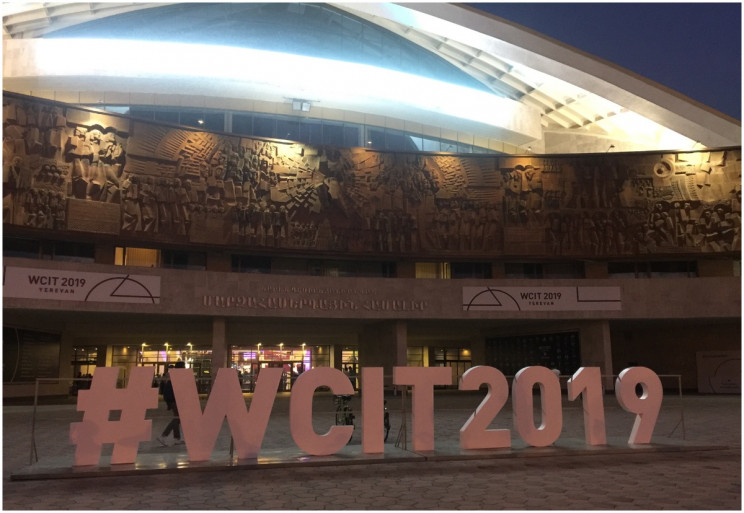How Sustainable is High-Tech?

WCIT Yerevan
Susan Fourtané for Interesting Engineering
YEREVAN, Armenia -- The current climate change emergency and the mobilization of thousands of activists around the world demanding governments to take the issue seriously has also had an impact on the technology industry.
As a result, technology leaders around the world gathered this week at the 23rd World Congress of Information Technology (WCIT) hosted by Armenia in its capital city, Yerevan, to discuss and exchange ideas on what measures can the information communications technology (ICT) industry take to contain and wisely manage its own use of energy and resources.
It is usually taken for granted that the sun and wind-powered new world of high-technology is cleaner and greener than the gritty old world of carbon and steel. However, not many give too much thought to the dark side. Yet, the reality is that powering vast amounts of high-tech infrastructure of data centers and switches demands the generation of great amounts of electrical energy.
Blockchain, Artificial Intelligence (AI), Big Data, 5G, Internet of Things (IoT), and the ever-more-data-hungry cryptography-based economy cannot exist without the generation of electrical energy. And the demands are going to increase even further.
So, how sustainable is high-technology really? The never-ending growth of data consumption demands the use of vast amounts of water and resources to power and cool the data centers and the technological infrastructure necessary to support the digital world. What is the cost and the impact on the environment? What about the impact of extracting and disposing of the toxic material that go into the manufacture of high-technology?
How is the technology industry reacting to these and other questions and what is the ICT industry planning to contain and manage its own use of energy and resources?
What does it mean to be green?
In his keynote speech at WCIT in Yerevan, Curt Hébert, Former Chairman of the U.S. Federal Energy Regulatory Commission (FERC), now full-time energy law lawyer said that "when we think about green initiatives we need to think about them from cradle to grave."
One of his examples focused on solar. "There is no carbon emissions generated from the electricity generated from solar. That's perfect," he said. However, the production of the photovoltaic panels has a carbon footprint. When looking at renewables we have to look at all the phases of solar power, for instance, and not just at the energy producing phase.
Hébert referenced an article by the Manhattan Institute published in the Wall Street Journal in May which mentions that the International Energy Agency (IEA) highlighted that "energy demand worldwide in 2018 grew by its fastest pace in the decade. Driven by robots, the global economy with fossil fuels is meeting nearly 70 percent of the growth for the second year running.
"Using wind, solar, and batteries as the primary sources for a nation's energy supply remains far too expensive. So, we have to figure that out. Cost is an issue. The economy is always an issue because when it comes to the price of electricity, who do we have to worry about? Regulators," he said. Regulators get to decide how much we have to change for the commodity."
According to Hébert, the reality from the financial point of view is that "there is a little chance that wealthy nations will agree to subsidize expenses for green tech for the rest of the world." He made a point saying that this means there is a need to understand the true cost of a green initiative.
Back to the example of solar energy, the life-cycle of the solar panel from cradle to grave produces carbon emissions. Mining, production, transportation, installation produce 3 to 13 percent of the energy that will be produced by the solar panel during its 30-year life-cycle, according to the National Renewable Energy Laboratory of the Department of Energy of the United States.
Hébert said that "there needs to be a balance between what we do environmentally, the environment itself, and the economy and economic development.
To make ICT greener we need
Following his keynote, Curt Hébert joined a panel discussion moderated by author Andrew Blum and integrated by Jenny Bofinger-Schuster, VP of Sustainability and Cities at Siemens; Brian Lillie, Former CPO of Equinix and Board Member of Lumentum & Talend; Ulili Onovakpuri, Partner at Kapor Capital; and John S. Shegerian, Founder and Executive Chairman at Electronics Recyclers International (ERI).
How green is Silicon?
"In 2004, electronics were the fastest growing solid waste stream in the world. Today, they are still the fastest growing solid waste stream in the world," said John S. Shegerian. "Just think about what we rely on our iPhones and iPads, gadgets in our cars and in our homes that make our lives better and more connected."
His message and call for recycling all electronics was clear. "All of those materials can be recycled responsibly and create a great outcome. Economic sustainability can merge with environmental sustainability and we can all participate in making the world a better place," Shegerian said.
In conclusion, to make Silicon greener we must pay attention to the cradle to grave life-cycle and we must do a better job. ICT cannot be supported by a renewable only energy today, but in the future this may be possible.
Related Articles:








Gloss